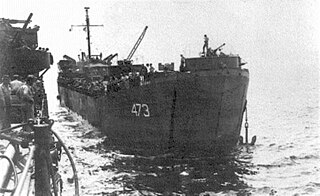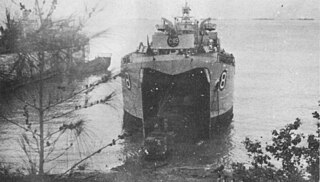
USS LST-1 was an LST-1-class tank landing ship of the United States Navy built during World War II. She was the lead ship in her class of 390 and like many of her class, she was not named and is properly referred to by her hull designation.

USS LST-5 was an LST-1-class tank landing ship of the United States Navy built during World War II. She was transferred to the Royal Navy in December 1944. Like many of her class, she was not named and is properly referred to by her hull designation.

USS LST-906 was an LST-542-class tank landing ship in the United States Navy. Like many of her class, she was not named and is properly referred to by her hull designation.

USS LST-472 was a United States Navy LST-1-class tank landing ship used in the Asiatic-Pacific Theater during World War II. As with many of her class, the ship was never named. Instead, she was referred to by her hull designation.

USS LST-4 was an LST-1-class tank landing ship of the United States Navy built during World War II. She was transferred to the Royal Navy in December 1944. Like many of her class, she was not named and is properly referred to by her hull designation.

USS LST-473 was a United States Navy LST-1-class tank landing ship used in the Asiatic-Pacific Theater during World War II. As with many of her class, the ship was never named. Instead, she was referred to by her hull designation.

USS LST-2 was an LST-1-class tank landing ship of the United States Navy built during World War II. She was transferred to the Royal Navy in November 1944. Like many of her class, she was not named and is properly referred to by her hull designation.

USS LST-7 was an LST-1-class tank landing ship of the United States Navy built during World War II. Like many of her class, she was not named and is properly referred to by her hull designation.

HM LST-8 was an LST-1-class tank landing ship of the United States Navy built during World War II. She was transferred to the Royal Navy in March 1943, before being commissioned into the USN. Like many of her class, she was not named and is properly referred to by her hull designation.

HM LST-9 was an LST-1-class tank landing ship of the United States Navy built during World War II. She was transferred to the Royal Navy in March 1943, before being commissioned into the USN. Like many of her class, she was not named and is properly referred to by her hull designation.
HM LST-11 was an LST-1-class tank landing ship of the United States Navy built during World War II. LST-11 was transferred to the Royal Navy in March 1943, before being commissioned into the USN. Like many of her class, she was not named and is properly referred to by her hull designation.

USS LST-12 was an LST-1-class tank landing ship of the United States Navy. LST-12 was transferred to the Royal Navy in early 1943, to serve in the Mediterranean Theater of Operations during 1943 and 1944. She never saw service with the US Navy.

HM LST-13 was an LST-1-class tank landing ship of the United States Navy built during World War II. She was transferred to the Royal Navy in April 1943, before being commissioned into the USN. Like many of her class, she was not named and is properly referred to by her hull designation.

USS LST-484 was an LST-1-class tank landing ship built for the United States Navy during World War II.

USS LST-456 was a United States Navy LST-1-class tank landing ship used in the Asiatic-Pacific Theater during World War II.

USS LST-474 was a United States Navy LST-1-class tank landing ship used in the Asiatic-Pacific Theater during World War II. As with many of her class, the ship was never named. Instead, she was referred to by her hull designation.
HMS LST-402/LSE-53 was a United States Navy LST-1-class tank landing ship that was transferred to the Royal Navy during World War II. As with many of her class, the ship was never named. Instead, she was referred to by her hull designation.
HMS LST-407 was a United States Navy LST-1-class tank landing ship that was transferred to the Royal Navy during World War II. As with many of her class, the ship was never named. Instead, she was referred to by her hull designation.
HMS LST-412 was a United States Navy LST-1-class tank landing ship that was transferred to the Royal Navy during World War II. As with many of her class, the ship was never named. Instead, she was referred to by her hull designation.
HMS LST-421 was a United States Navy LST-1-class tank landing ship that was transferred to the Royal Navy during World War II. As with many of her class, the ship was never named. Instead, she was referred to by her hull designation.















